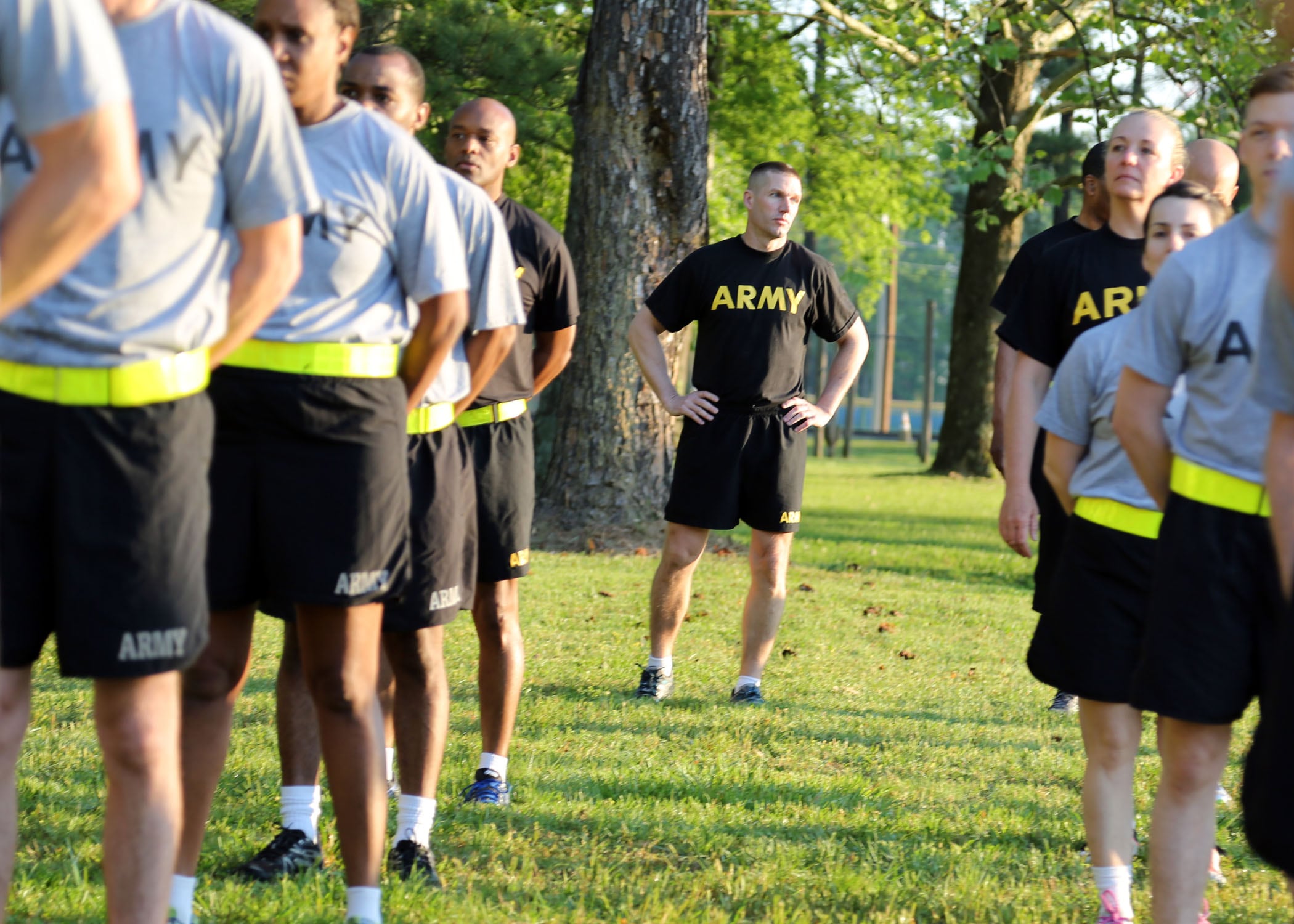Black socks with the PT uniform. Headphones with your uniform while in the gym.
You asked for these changes to AR 670-1, and Sergeant Major of the Army Dan Dailey is looking to make them reality.
The senior enlisted soldier plans to survey the force on these tweaks to the Army's regulation on appearance standards and, after a vote from his fellow senior noncommissioned officers, bring these changes to the service's uniform board for approval.
"If you can raise motivation by fixing things that don't really have a negative effect on the standards and discipline of the Army, why not?" he said.
But there are some things Dailey is not willing to compromise: body composition standards and the contentious tape test.
"We're getting rid of people who don't meet the [weight] standard," he said. "We're seeing an increased number of people who are being flagged. It's the health of the force. The No. 1 growing cost of a soldier is health. All those things that exponentially make soldiers unhealthy and make it difficult for them to do their jobs, I'm very passionate about that."
Since 2010, more than 7,300 soldiers have been separated from the Army for non-compliance with the Army's Weight Control Program, said Hank Minitrez, a spokesman for the Army personnel directorate (G-1).

Sergeant Major of the Army Dan Dailey has made fitness a renewed priority for the enlisted ranks.
Photo Credit: Sgt. 1st Class Michael R. Zuk/Army
The number of weight-related enlisted separations grew from 460 in fiscal year 2010 to 1,823 in fiscal 2013, according to data from G-1. Between October and March, 739 soldiers were cut for being overweight.
Dailey, a fitness buff who's deployed four times to Iraq, said the wars in Iraq and Afghanistan caused the Army to get away from regular physical fitness training.
"It's indicative of war," he said. "You get focused on deployments for 12 months, and a lot of soldiers are in places that make it very hard [to do PT]."
A closer look at Dailey's stance on uniform changes and body fat:
Black socks
The idea for black socks with the Army's new black PT uniforms came up at several town hall meetings Dailey conducted with soldiers.
It was a topic Dailey himself brought up, based on the soldier feedback he had received, during a June 4 town hall at Fort Meade, Maryland. Most of the 100-plus soldiers there liked the idea.
"Soldiers said, 'hey, why can't we wear black socks with our PT uniform?'" Dailey said. "It wasn't that we couldn't, but we had never thought about it."
Socks worn during PT should be calf- or ankle-length and plain white with no logos, according to Army Regulation 670-1. The socks also must cover the entire ankle bone.

Many soldiers sa they want the OK to wear black socks with their PT uniform.
Photo Credit: Army
Dailey brought the soldiers' feedback to Army Chief of Staff Gen. Ray Odierno, who was not opposed to giving soldiers the sock color option, Dailey said.
Dailey will now survey soldiers across the Army to make sure it's something most soldiers support, and bring up the issue with the Senior Enlisted Council, a group of senior command sergeants major from across the Army that meets monthly to discuss a variety of issues.
"The chief asked me to first survey the soldiers, make sure this is the majority and not just a small contingent," he said.
Once that's done, Dailey will need to get the change approved by the Army's uniform board.
"We're not opposed to [black socks] at all," Dailey said. "We've just got to make sure we follow procedures."
Headphones
The other issue many soldiers have brought up to Dailey is the ability to wear headphones if they're working out in a gym in their PT uniform.
AR 670-1 prohibits soldiers from wearing wireless or non-wireless devices or earpieces while wearing Army uniforms. But a soldier dressed in civilian clothes is able to work out in the same gym and wear his headphones.
"We've got to look at it," Dailey said. "It's something I'm not opposed to."

Modern mp3 player
Photo Credit: Getty Images/iStockphoto
It would be "pretty hypocritical" to allow soldiers in civilian clothes to wear headphones in the gym but not those in uniform, he said.
"What's preventing them from wearing their PT uniform when they have the choice is the fact that they like to listen to their headphones when they work out, and so do I," Dailey said. "I want them wearing their PT uniform."
As for wearing the headphones while doing PT outside? Citing safety concerns, "they never will be able to. Never," Dailey said.
Renewed focus on fat
The push for increased physical fitness "is something we're going to be focusing very heavily on for the next couple years," Dailey said.
Fitness is a "critical reason" why the United States Army is the best on the battlefield, Dailey said.
"Most armies don't come close to the level of physical fitness that we require of our soldiers," he said. "When you're in Iraq, and you see our soldiers tactically move against the enemy, [the enemy] doesn't have the ability to move like that. Or imagine you're 12,000 feet up in a mountain, and you're carrying 100 pounds on top of that. It's hard to perform at that altitude."
Physical fitness is something Dailey has pushed hard since being sworn in as the sergeant major of the Army on Jan. 30.
It's not uncommon for Dailey, in his travels across the Army, to see a soldier who's overweight. He typically will bring it up with that soldier's chain of command. In most cases, Dailey said, that soldier is already flagged.
Earlier this spring, Dailey called to task leaders for allowing fitness standards to slide among their troops.
"One of the most important things that we do every day is typically one of the first things that we do each morning, that being physical fitness training," Dailey wrote in a March 30 letter to the force. "Yet as I travel to various locations across the Army, I find fewer and fewer soldiers actually conducting physical training."
Dailey said he knows it can be easier said than done, but physically fit soldiers are healthier over time, and they're ready for any mission they might be called upon to do.
"There are a million things out there that will compete with that hour [of PT]," he said. "It's the sacred hour, and you've got to preserve it."
The ability to operate effectively on the battlefield is one key reason why Dailey said he is "extremely" and "absolutely" opposed to changing the Army's body composition standards.
"Imagine carrying a 350-pound person on the battlefield when he or she gets shot," Dailey said. "I'm telling you right now, you're not doing it. That's not going to happen. You'll take a whole squad out."
In June, Navy Secretary Ray Mabus ordered a comprehensive review of the Navy and Marine Corps' fitness programs. As a result, the Navy is planning to try new methods of assessing body composition, with plans to "focus on evaluating health, not shape," Mabus said.
In April, the Coast Guard made the decision to allow new Coast Guardsmen to exceed the maximum allowed weight if their body-fat percentage is within regulation. It also made changes to the rules for taking and recording body-fat measurements across the service.
In the Army, 17- to 20-year-old men are allowed 20 percent body fat; women in that age group are allowed 30 percent, according to Army Regulation 600-9.
Men ages 21 to 27 are allowed 22 percent body fat, women are allowed 32 percent.
Men who are 28 through 39 can have 24 percent body fat, while women in that age group are allowed 34 percent.
Soldiers 40 and older can have 26 percent body fat for men and 36 percent for women.
Dailey said a recent program allowing recruits with slightly higher body-fat percentages to join the Army as long as they lost the weight within a certain amount of time was a failure.
"The analysis was almost 100 percent of those individuals reverted back to being overweight," he said. "Our analysis says that doesn't reflect health and what soldiers need to be doing on the battlefield."
The Assessment of Recruit Motivation and Strength, or ARMS, was designed to measure cardiovascular and upper-body strength and endurance to identify potential recruits who were likely to complete basic training even though they exceeded the Army's weight standards.
Initial ARMS results appeared favorable, but further review showed that most of the participants were failing the PT test or became overweight at rates much higher than those of the rest of the force. ARMS was terminated in 2012.
Soldiers who carry excess body weight have increased lower extremity injuries and a decreased ability to be able to perform on the battlefield, Dailey said.
"America's getting fatter every day … but that doesn't mean we need to grow," he said about the Army.
One argument for loosening body composition requirements is the ability to recruit from a larger pool of young people, many of whom are disqualified from enlisting because of their weight.
"[Weight] is a big discriminator, so that would open us up to a lot more qualified applicants," Dailey said. "My point is, sure, you can do a whole bunch of things to open up the aperture, but lessening the standards is not one we need to do, especially when you're reducing the size of the force. When you decrease in size, you've got to increase in efficiency."
Dailey also said he believes the tape test — which troops have long complained is unfair and an inaccurate gauge of fitness — is "a very good predictor of body fat composition."
In 2013, Military Times put the tape test to the test by taping 10 active-duty troops stationed in the Pacific Northwest and then putting them in a hydrostatic "dunk tank," considered among the gold standards for determining actual body fat composition.
The results showed not once did the taping match the dunk test results. The tape test was wrong every time, and in nine out of 10 cases, the tape method measured troops' body fat percentages higher - the worst was a 66 percent difference between the scores. The closest was nearly 12 percent off.
Dailey said the tape test is typically more lenient than other tests.
"I don't have any skinny people complain about it," he said. "The people who are failing the tape test, they're fat. I was a master trainer my entire career. I never failed a skinny person."
Michelle Tan is the editor of Army Times and Air Force Times. She has covered the military for Military Times since 2005, and has embedded with U.S. troops in Iraq, Afghanistan, Kuwait, Haiti, Gabon and the Horn of Africa.




